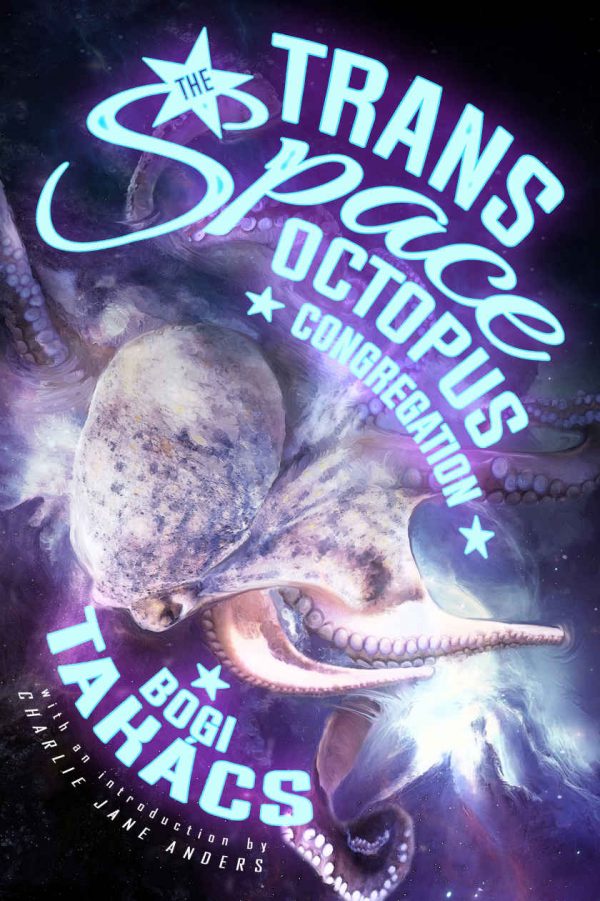
It’s time again for another F&SF review, one of the more enjoyable parts of writing a (mostly) weekly column. For various reasons, I’ve had to divide this review into two parts.
When I was a teen, it was actually possible to read a dozen or more print SF/F magazines monthly; today, there are very few left. (We have many new and newer online SF/F publications, which is gratifying.) One of the few remaining older publications is The Magazine of Fantasy and Science Fiction, or F&SF, which continues to maintain a high quality of both fiction and nonfiction.
I won’t review the nonfiction; you can find it online at SF Site (click the name for the link). I will review both fiction and poetry as best I am able, and in no particular order. This issue’s cover is by Alan M. Clark, illustrating “All Hail the Pizza King and Bless His Reign Eternal,” by David Erik Nelson.
So let’s begin with “A Quartet of Alphabetic Bubbles,” a poem by Mary Soon Lee. It comprises four poems ranging from seven to nine lines each. All are short descriptions of SFnal settings; each poem is precisely twenty-six words long; each word is in alphabetical order (I presume you don’t need to be told the order.) A brave compendium directly exposing fictional greatness! Heavy indeed!
Next up is “The Staircase,” by Stephanie Feldman. It’s a story about a group of five friends (plus the unnamed first-person protagonist) in high school, who do everything together. There’s Jo, and Maria, and Addison, and Tasha, who have been friends since first grade. Now they’re in twelfth grade, and they’ve never fought. (There have been occasional freakouts, when one of them feels left out, but those are rare.) Every Friday they meet at the diner for pumpkin pies and curly fries. But their town has a peculiarity: two roads that cross at the top of a hill, going off in all four cardinal directions. That’s not terribly peculiar, but there’s a fifth cardinal direction there: a wooden staircase that leads down the hill towards a Victorian mansion, and tales are told about that staircase in the school. Specifically, that anyone who goes down the staircase disappears.
Nobody knows anyone for sure who’s disappeared—it remains a school legend, until one Friday, when Jo goes down the stairs following a deer that the group thinks they saw disappear. Jo vanishes too… but when she reappears, she denies ever being gone. It’s a kind of coming-of-age story in its core, and if I had to compare it, I’d think it reminds me a bit of Nina Kiriki Hoffman’s fiction—and that’s high praise indeed. You’ll have to read the story to see how it ends; I will be looking for more from this author.
Rati Mehrotra’s “Knock, Knock Said the Ship” is a pure SF story from an author born in India who had a career as an economist (among other things) before she moved to Canada and started writing. Her story is about an intelligent spaceship named Kaalratri, and a young woman named Deenu. Kaalratri was a hospital ship until she had lost all her patients in an accidental missile strike. She was still trying to recover from that episode, just as Deenu was trying to recover from the wars on Luna that had killed most of the Lunarians, including her family. She had been rescued by one of Kaalratri’s drones, and now owed money to the captain for her life. Deenu didn’t think she’d ever repay the amount owed, because everything she did added on to the prinicpal.
Possibly because of their similar experiences, Deenu and the ship bond to a certain degree. At least, Kaalratri starts asking Deenu “knock knock” questions. You know, “knock knock. Who’s there? You. You who?” That sort of thing. Deenu isn’t certain that this is a good sign; is the ship going crazy? On a supply run to the asteroid belt, the ship is boarded by Peace Officers looking for contraband, they said. There’s a very clever sequence and resolution to this story that in some ways reminds me of Martha Wells’ Murderbot, though without that AI’s cynicism and disdain for humans. I can’t say any more without spoiling it. But I think you’ll like it.
Next is “The Shape of Gifts” by Natalia Theodoridou. Our protagonist, Terry, is some kind of ecology documenter, perhaps. The world’s ecology has finally reached the tipping point. She’s in the forest to examine things like birds’ nests and document how the eggs are faring, things like that. There’s something different about our narrator, however. She needs to take care, because she has a “gift,” maybe from “the gods,” maybe not. At any time, somethng she sees—like a flight of wild geese—may trigger a fugue state, during which she sees the future. But only the bad things: a friend’s death, for instance, or the death of someone she doesn’t even know. She’s been doing this for, possibly, many lifetimes.
Her memory is faulty, she may be—who knows? Certainly not her—immortal. And the body she is wearing now may not be the same body she was wearing before… many times before. Not the same gender, even. Ms. Theodoriou has made the possible end of the world—it’s coming, thanks to ecological collapse (in the story, that is)—sound somewhat lyrical. You’ll have to read it to find out more about our protagonist. I think you’ll be pleasantly surprised. This story partakes more of the fantasy side than the SF side, but it’s kind of (dare I say?) magic realism?
James Morrow’s “Bible Stories for Adults No. 37: The Jawbone,” is apparently the first one of these he’s written for over 25 years; the last one (No. 17, in 1989, “The Deluge,”) won a Nebula award. In this case, the Bible story is told by the Angel of Death and, as you might guess, is about Samson the Mighty, who reportedly slew a bunch of Philistines with the jawbone of an ass. This is not your standard Bible story, however; it’s more about how the unbridled arming of the Philistines with magical weapons became the cause of their downfall and the downfall of that temple that Samson supposedly pulled down—killing himself and the priests (and, for all I know, Dellilah… it’s been many years since I had occasion to read that story). And, you should know, the Philistines had their own NRA, the National Retailers of Assbones—run by an Egyptian named Phut. (Rather than just jawbones, it was found that any old donkey bone could become a deadly weapon with the right spell.) This is a cautionary tale for sure!
And the cover story is “All Hail the Pizza King and Bless His Reign Eternal,” by David Erik Nelson. How to describe this one? Well, let’s see, it’s about a woman named Melissa (“Lissa”), who’s married to Seth, and whose sister-in-law is SherriLynn. They live in Jackson County, Michigan, where Kip’s Taco Burger was the best pizza place in town. And his taco burgers were to die for (in one case, literally). Seth and his sister grew up in the Florida Panhandle, and his sister has just in the past year come to live with Seth and Lissa, a fact that has given Lissa no end of trouble. Because SherriLynn is addicted to Seinfeld, and hs forced them to watch an episode every single night until she (Lissa) can recite every episode by heart—especially the Soup Nazi one, for reasons that will be apparent if you read the story (‘cause I’m not telling!).
Anyway, at some point, SherriLynn bought some bitcoin when it was dirt cheap, and she’s now sold them and bought Kip’s Taco Burger—which went out of business years ago when Kip murdered his wife and… yep. You guessed it. Made taco burgers out of her. But there’s an even closer connection to Kip and his Taco Burger stand than SherriLynn’s purchase. On the day that Kip was found out, Lissa—at this point only 17 years old—had stopped in from school to get one of Kip’s ever-so-tasty taco burgers. That’s the gross part of the story. There’s a lot more to it, including a nifty resolution to the story, but you’ll have to pick up the issue to find out what it is.
So, that’s Part I of my review of the July-August issue. Next week I’ll conclude the current issue, and the week or so after that, I’ll review the current, that is to say, September/October issue. I’m looking forward to that one, which has a terrific Bob Eggleton cover. See you then!
I received an email from William, in Midlothian, Texas the other day. He said, “Read your article about your ‘pilgrimage’ to Butler. I believe I am more of a man and a better person than I would have been without Robert A. Heinlein’s writings, which I discovered in a small-town library. I’ll continue to contribute to the Butler Library from time to time.” Thanks, William! I agree with you; I think RAH specifically (and SF in general) has improved and informed me throughout my life. And I’m sure the Butler Library will be happy to get any contribution, however small. I’ll do the same myself when I can! It’s letters like William’s that make this column worth writing!
You (yes, you!) can comments on my column too, y’know. You can comment here, or on Facebook page, or even by email, like William—just use stevefah at hotmail dot com. All your comments, good or bad, positive or negative, are welcome! (Just keep it polite, okay?) My opinion is, as always, my own, and doesn’t necessarily reflect the views of Amazing Stories or its owner, editor, publisher or other columnists. See you next time!









